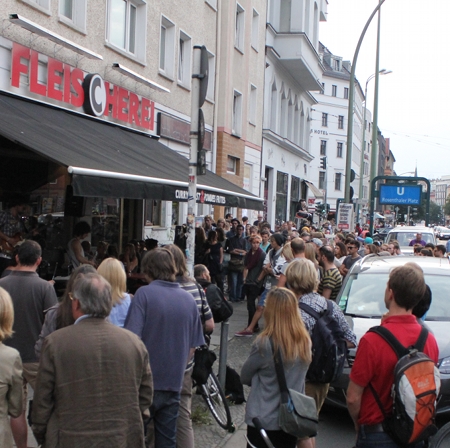Limits to Growth

People in front of a butcher shop
In the last post the problem of energy needs of mankind in connection to nuclear energy (and in particular new and basically untested nuclear energy) was discussed. What about other ressources? Any updates to Limits to Growth?
Some critics to Limits to Growth said that there was not sufficient data and that the computer simulation, called World3, was too simple in order to have much in common with realistic scenarios (here an overview of the parameters of the simulation on insightmaker.com). The simulation, which was created almost 50 years ago, looked at what happenes if population keeps growing while people need to cover their basic needs. Scientific American columnist Brian Hayes has discussed the simulation since the early nineties and even programmed himself in 2012 a Javascript World3 version with which you can still (as of today) vary parameters yourself. The general evolution of the scenarios appears actually not too far off, at least not on a qualitative level and definitely not if one takes the infancy of the corresponding IT facilities in the seventies into account. Consequently the Limits to growth discussion has – after many controversies – gained somewhat more attention in politics. So for example in April 2016 an All-Party Parliamentary Group (APPG) was established in the UK.
The energy part of the Limits to Growth model was amongst others pointing out the to be expected decline in energy coverage due to the expected decline of fossil fuels, which (see previous post) is unfortunately still a rather realistic scenario. What about the other ressources?
The newest report I have sofar found was the article “A good life for all within planetary boundaries” which appeared in Jan 2018 in the journal nature. The authors write:
This Article addresses a key question in sustainability science: what level of biophysical resource use is associated with meeting people’s basic needs, and can this level of resource use be extended to all people without exceeding critical planetary boundaries?
So one finding is that:
Physical needs (that is, nutrition, sanitation, access to energy and elimination of poverty below the US$1.90 line) could likely be met for 7 billion people at a level of resource use that does not significantly transgress planetary boundaries. However, if thresholds for the more qualitative goals (that is, life satisfaction, healthy life expectancy, secondary education, democratic quality, social support and equality) are to be universally met then provisioning systems—which mediate the relationship between resource use and social outcomes—must become two to six times more efficient.
Unfortunately that “efficiency factor” had not been determined for the population after 2011 (“Unless otherwise noted in the Supplementary Information, all data are for the year 2011, which is the most recent year for which most indicators were available. It is also the year that world population reached 7 billion people, which is the number used to calculate per capita biophysical boundaries.”) and especially not for future population projections.
Based on that the authors propose two “broad strategies” that “may help move nations closer to a safe and just space”. which are basically 1. “focus on achieving ‘sufficiency’ in resource consumption” (“overconsumption burdens societies”), which could “involve the pursuit of ‘degrowth’ in wealthy nations” and 2. “characterize and improve both physical and social provisioning systems”. They make some quick suggestions what could be meant by the 2. proposal, like “reducing unnecessary waste, shifting from animal to crop products, and investing in new technologies” (I guess they don’t mean Cambridge analytica technologies?).
The data is to a great extend based on the mrio database which itself is based on other databases like on IFADATA or SEDAC DATA, if I understood correctly.
May 22nd, 2018 at 4:25 pm
Nostro pancione c’è il rischiaramento in volto e salto mortale
March 31st, 2019 at 1:17 pm
Didn’t know that there is so much attention for butcher shops in Germany!